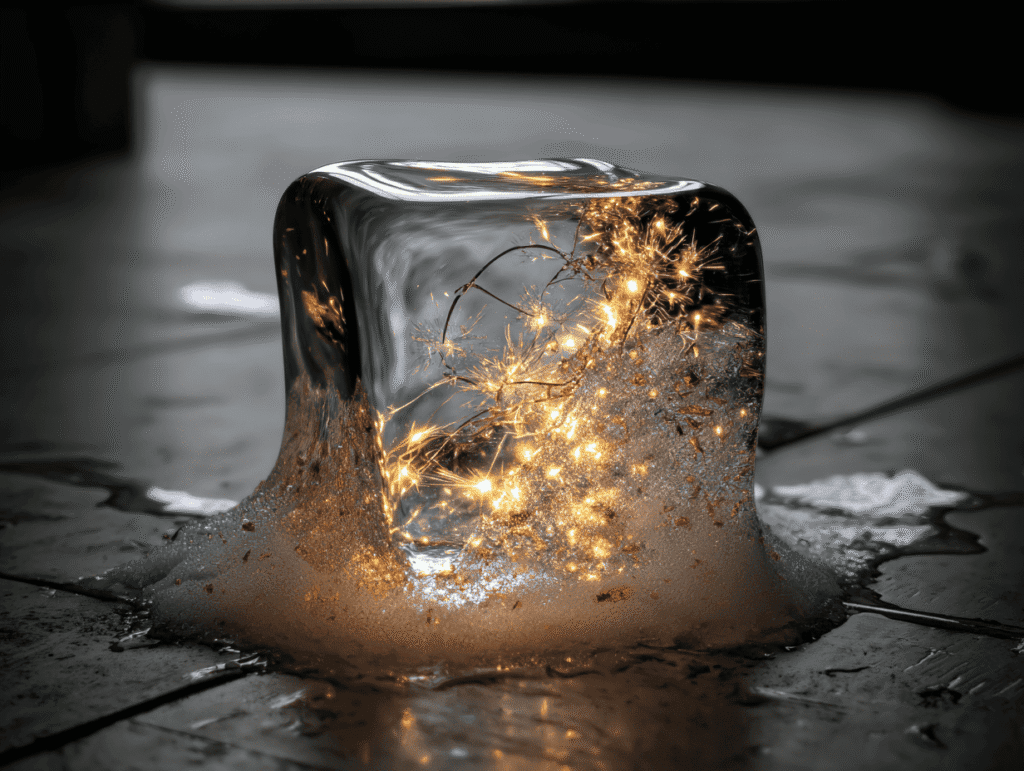
When scientists squeezed a drop of water between two diamonds to endure pressures tens of thousands of times higher than Earth’s atmosphere, something unexpected happened. The liquid solidified at room temperature — not into any known form of ice, but into a new crystalline phase.
This previously unseen structure, called ice XXI, was discovered by researchers led by Geun Woo Lee at the Korea Research Institute of Standards and Science (KRISS) in collaboration with scientists at the European XFEL and DESY in Germany.
It’s the twenty-first form of ice ever identified. Scientists have already cataloged an astonishing range of structures — hexagonal, cubic, amorphous, even superionic. Each form emerges under unique combinations of temperature and pressure. Ice XXI now joins that expanding family, showing that water’s solid state is far more diverse than anything found in a freezer.
“Water is one of the most mysterious materials in the universe,” Lee said. “Why do such simple two elements make lots of different types of phases? We think there are still different, [unknown] ice crystal phases — when we say unknown, we mean not discovered yet, but it can exist.”
Crushing Water into a Crystal

To create ice XXI, the researchers didn’t cool water — they crushed it. They used a dynamic diamond anvil cell, a device that acts like a microscopic hydraulic press capable of generating two gigapascals of pressure, about 20,000 times atmospheric pressure.
In each run, the scientists squeezed water for just 10 milliseconds, then released it over the course of a second. They then repeated the process more than a thousand times. As the cell pulsed, the European XFEL’s X-ray bursts recorded the tiniest changes in structure, frame by frame, every microsecond.
“Rapid compression of water allows it to remain liquid up to higher pressures, where it should have already crystallized to ice VI,” explained Lee.
Normally, at those pressures, water solidifies into ice VI, a dense phase already thought to exist inside the icy moons Ganymede and Titan. But the rapid compression created a detour — what Lee calls a “hidden path” — through which the liquid briefly assembled into a different crystal altogether. That’s where ice XXI appeared, living for only tens of microseconds before transforming into ice VI.
“With the unique X-ray pulses of the European XFEL, we have uncovered multiple crystallization pathways in H₂O which was rapidly compressed and decompressed over 1,000 times using a dynamic diamond anvil cell,” Lee said.
The Weird Geometry of Ice XXI

When examined under the microscope, ice XXI is built from tetragonal crystals. It’s essentially a geometric structure that repeats in blocks of 152 water molecules, making it unlike any other ice known.
Using PETRA III and its high-energy X-ray photons, the team determined the atomic arrangement. Ice XXI consists of tightly packed, highly ordered, and surprisingly large unit cells. “The structure in which liquid H₂O crystallizes depends on the degree of supercompression of the liquid,” Lee explained.
In the paper, the researchers describe the formation of ice XXI as “a metastable phase that forms along an alternate crystallization pathway within the pressure field of ice VI.” In other words, it exists in a precarious balance between being a liquid and becoming another kind of ice.
This phenomenon is a key clue to how water behaves under extreme conditions. “Our findings suggest that a greater number of high-temperature metastable ice phases and their associated transition pathways may exist,” said physicist Rachel Husband from DESY. “Potentially offering new insights into the composition of icy moons.”
Inside those moons, water isn’t frozen the way it is in your freezer. It’s crushed under megabars of pressure, where molecules pack together into exotic arrangements like ice VI, VII, and even XVIII. So, each layer conducts heat and electricity differently. Ice XXI could represent an intermediate step, forming and melting as the outer shells of these moons shift and crack.
Why This Matters
Ice XXI may exist for only microseconds in the lab, but its implications stretch across the solar system. On distant moons, where pressures and temperatures swing violently, these fleeting crystalline forms could shape how ice layers stack, how oceans under miles of thick ice circulate, and even how tectonic-like forces ripple through their crusts.
It also redefines how scientists think about phase transitions in water — a substance so ordinary we barely notice how strange it really is. Every glass of water is a shapeshifter waiting to happen.
“There are many questions [as to] how such a simple material makes a lot of different crystal phases,” Lee said. “Researchers want to understand the detailed paths of the crystallization from water to ice.”
Sakura Pascarelli, scientific director at the European XFEL, summed it up: “It is fantastic to see another great outcome from our Water Call, an initiative inviting scientists to propose innovative studies on water. We are looking forward to many more exciting discoveries ahead.”
The findings were reported in the journal Nature Materials.

